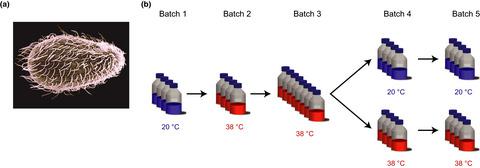当前位置:
X-MOL 学术
›
Ecol. Evol.
›
论文详情
Our official English website, www.x-mol.net, welcomes your
feedback! (Note: you will need to create a separate account there.)
Phenotypic responses to temperature in the ciliate Tetrahymena thermophila.
Ecology and Evolution ( IF 2.3 ) Pub Date : 2020-07-01 , DOI: 10.1002/ece3.6486 Vanessa Weber de Melo 1 , Robert Lowe 2 , Paul J Hurd 3 , Owen L Petchey 1
Ecology and Evolution ( IF 2.3 ) Pub Date : 2020-07-01 , DOI: 10.1002/ece3.6486 Vanessa Weber de Melo 1 , Robert Lowe 2 , Paul J Hurd 3 , Owen L Petchey 1
Affiliation

|
Understanding the effects of temperature on ecological and evolutionary processes is crucial for generating future climate adaptation scenarios. Using experimental evolution, we evolved the model ciliate Tetrahymena thermophila in an initially novel high temperature environment for more than 35 generations, closely monitoring population dynamics and morphological changes. We observed initially long lag phases in the high temperature environment that over about 26 generations reduced to no lag phase, a strong reduction in cell size and modifications in cell shape at high temperature. When exposing the adapted populations to their original temperature, most phenotypic traits returned to the observed levels in the ancestral populations, indicating phenotypic plasticity is an important component of this species thermal stress response. However, persistent changes in cell size were detected, indicating possible costs related to the adaptation process. Exploring the molecular basis of thermal adaptation will help clarify the mechanisms driving these phenotypic responses.
中文翻译:

纤毛虫嗜热四膜虫对温度的表型反应。
了解温度对生态和进化过程的影响对于生成未来的气候适应情景至关重要。通过实验进化,我们在最初新颖的高温环境中进化了纤毛虫四膜虫模型超过 35 代,密切监测种群动态和形态变化。我们在高温环境中观察到最初的长滞后期,经过大约 26 代后减少到无滞后期,高温下细胞尺寸大幅减小,细胞形状发生改变。当适应群体暴露于原始温度时,大多数表型性状恢复到祖先群体中观察到的水平,表明表型可塑性是该物种热应激反应的重要组成部分。然而,检测到细胞大小的持续变化,表明与适应过程相关的可能成本。探索热适应的分子基础将有助于阐明驱动这些表型反应的机制。
更新日期:2020-07-30
中文翻译:

纤毛虫嗜热四膜虫对温度的表型反应。
了解温度对生态和进化过程的影响对于生成未来的气候适应情景至关重要。通过实验进化,我们在最初新颖的高温环境中进化了纤毛虫四膜虫模型超过 35 代,密切监测种群动态和形态变化。我们在高温环境中观察到最初的长滞后期,经过大约 26 代后减少到无滞后期,高温下细胞尺寸大幅减小,细胞形状发生改变。当适应群体暴露于原始温度时,大多数表型性状恢复到祖先群体中观察到的水平,表明表型可塑性是该物种热应激反应的重要组成部分。然而,检测到细胞大小的持续变化,表明与适应过程相关的可能成本。探索热适应的分子基础将有助于阐明驱动这些表型反应的机制。











































 京公网安备 11010802027423号
京公网安备 11010802027423号